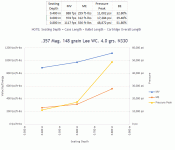Because of the long distance the deeply seated bullet has to jump to the throat, it is probably leaking gas around the bullet and limiting both velocity and causing some gas cutting of the lead, which affects accuracy adversely. Second, because you can't crimp the bullet that far down in the case, any small differences in case diameter will affect bullet pull more than in normally seated and crimped cases. For that reason, your start pressure is likely to vary more than with a bullets properly seated and with a roll crimp into the bullet crimp groove. Try seating some in the normal way. Using the same charge of powder you will get less velocity, but it should be more consistent.
There are also some things that can cause chronograph readings to be in error. The most common one is shooting too close to the instrument so that muzzle blast causes false triggering. Shooting close to the ground will mean muzzle blast also kicks up dust, which can be an issue with false readings, too.
If you don't have a tripod for the chronograph, try getting at least three meters away from it. You can also take a cardboard carton and cut it out to create a blast shield. You make a wide (2 or 3 inches or 50-75 mm) vertical slot in the middle of each end of the box and set it right in front of you and line the slots up with the target and chronograph, You shoot through the slits or put the muzzle inside the near slit. The bottom of the box will stop prevent dust kick-up when you are on the ground.
Another problem is glint. This when light reflected off the ground bounces off the bullet, causing a false reading of it's location. For shooting with the instrument on the ground, find a piece of cardboard about four feet long and two feet wide and paint it flat black and set the chronograph on it to stop glints.
There are also some things that can cause chronograph readings to be in error. The most common one is shooting too close to the instrument so that muzzle blast causes false triggering. Shooting close to the ground will mean muzzle blast also kicks up dust, which can be an issue with false readings, too.
If you don't have a tripod for the chronograph, try getting at least three meters away from it. You can also take a cardboard carton and cut it out to create a blast shield. You make a wide (2 or 3 inches or 50-75 mm) vertical slot in the middle of each end of the box and set it right in front of you and line the slots up with the target and chronograph, You shoot through the slits or put the muzzle inside the near slit. The bottom of the box will stop prevent dust kick-up when you are on the ground.
Another problem is glint. This when light reflected off the ground bounces off the bullet, causing a false reading of it's location. For shooting with the instrument on the ground, find a piece of cardboard about four feet long and two feet wide and paint it flat black and set the chronograph on it to stop glints.

